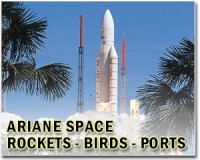 |
Kourou, French Guiana (ESA) Dec 31, 2010 This evening, an Ariane 5 launcher lifted off from Europe's Spaceport on a journey to place two telecommunications satellites, Hispasat-1E and Koreasat-6, into their planned transfer orbits. Flight V199 was the sixth Ariane 5 launch of 2010 and the last of the year. Liftoff of the 55th Ariane 5 mission came at 22:27 CET (21:27 GMT; 18:27 French Guiana). The target injection orbit had a perigee altitude of 250 km, an apogee altitude at injection of 35 786 km and an inclination of 3 degrees . The satellites were accurately injected into their transfer orbits about 27 minutes and 34 minutes after liftoff, respectively. Hispasat-1E will be positioned in 'geostationary orbit' above the equator at 30 degrees W. It will provide direct-to-home television, digital terrestrial television and high-definition television services, as well as value-added broadband services to mobile, land and maritime users. Koreasat-6, to be positioned over 116 degrees E, carries 24 Ku-band channels to provide Fixed Satellite Services and six channels for Direct Broadcast Services. Satellites in a circular orbit over the Equator at an altitude of 35 800 km keep pace with Earth's rotation and appear stationary when observed from Earth, hence 'geostationary'. The payload mass for this launch was 9259 kg; the satellite masses totalled 8170 kg, with payload adapters and dispensers making up the additional 1089 kg.
V199 flight timeline The solid boosters were jettisoned 2 min 20 sec after main engine ignition, and the fairing protecting the payload during the climb through Earth's atmosphere was discarded at 3 min 9 sec. The launcher's main engine was shut down at 8 min 55 sec; six seconds later, the main cryogenic stage separated from the upper stage and its payload. Four seconds after main stage separation, the engine of the cryogenic upper stage was ignited to continue the journey. The engine was shut down at 25 min 2 sec into the flight, at which point the vehicle was travelling at 9359 m/s (33 692 km/h) at an altitude of 642 km. The conditions for geostationary transfer orbit injection had been achieved. At 27 min 27 sec after main engine ignition, Hispasat-1E separated from the upper stage, followed by Koreasat-6 at 34 min 12 sec. Ariane 5's flight operations were completed 47 min 34 sec after main engine ignition.
Share This Article With Planet Earth
Related Links Arianespace Launch Pad at Space-Travel.com
 Europe launcher puts Spanish, S.Korean satellites into orbit
Europe launcher puts Spanish, S.Korean satellites into orbitKourou, French Guiana (AFP) Dec 30, 2010 An Ariane 5 heavy rocket lifted off from Europe's space base on French Guiana Wednesday and put into orbit the South Korean Koreasat 6 and Spanish Hispasat 1E telecommunications satellites. The launch from Europe's Spaceport in Kourou was the Ariane 5 launcher's sixth and last mission of the year, Arianespace said in a statement. Lift-off at 6:27 pm (2127 GMT) was delayed by about 24 hou ... read more |
|
| The content herein, unless otherwise known to be public domain, are Copyright 1995-2010 - SpaceDaily. AFP and UPI Wire Stories are copyright Agence France-Presse and United Press International. ESA Portal Reports are copyright European Space Agency. All NASA sourced material is public domain. Additional copyrights may apply in whole or part to other bona fide parties. Advertising does not imply endorsement,agreement or approval of any opinions, statements or information provided by SpaceDaily on any Web page published or hosted by SpaceDaily. Privacy Statement |